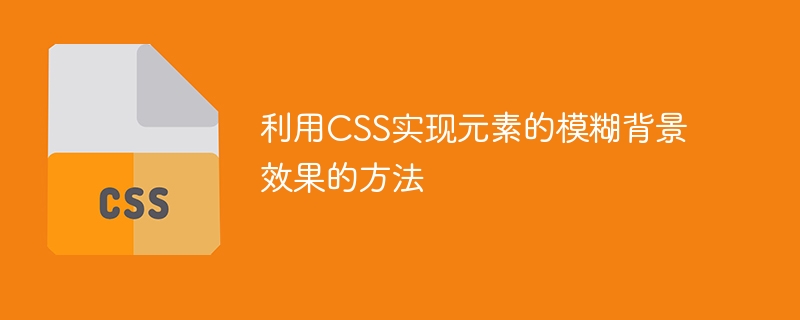

The method of using CSS to achieve the blurred background effect of elements requires specific code examples
With the continuous development of web design, how to make page elements appear elegant and unique The effect has become one of the focuses of designers. One of the common effects is to blur the background. By blurring the background of elements, the layering and aesthetics of the interface can be enhanced. In this article, we will introduce how to use CSS to achieve the blurred background effect of elements and provide specific code examples.
To achieve the blurred background effect of elements, we need to use the filter attribute in CSS. This property can change the appearance of the element through a series of filter effects. Among them, the blur() function can achieve the blur effect. The following is a sample code that uses the filter attribute and the blur() function to blur the background of an element:
<style>
.blur-bg {
background-image: url("背景图片地址");
background-position: center;
background-repeat: no-repeat;
background-size: cover;
filter: blur(5px);
-webkit-filter: blur(5px); /* 兼容Webkit浏览器 */
}
</style>
<div class="blur-bg">
<!-- 页面内容 -->
</div>In the above code, we are given a CSS style with a class name of blur-bg. In this style, we set the background image of the element (through the background-image attribute), center the background image (through the background-position attribute), and adapt the background image to the size of the element (through the background-size attribute whose value is cover ). Additionally, we added the filter attribute and set its value to blur(5px). This will make the background image blurry.
It should be noted that in order to ensure that the blur effect can be displayed normally in various browsers, we also use the -webkit-filter attribute and set its value to blur(5px). This is compatible with Webkit-based browsers such as Chrome and Safari.
The above code is just a way to achieve the blurred background effect of elements. You can adjust and modify it according to specific design needs. For example, you can adjust the degree of the blur effect to make it softer or more pronounced by changing the parameters of the blur() function.
Summary:
In this article, we introduced how to use the CSS filter property and blur() function to achieve the blurred background effect of elements. With simple CSS code, we can easily add unique and beautiful visual effects to elements. Hope these sample codes can help you apply blur background effect in web design and add charm to your pages.
The above is the detailed content of How to use CSS to achieve a blurred background effect on elements. For more information, please follow other related articles on the PHP Chinese website!